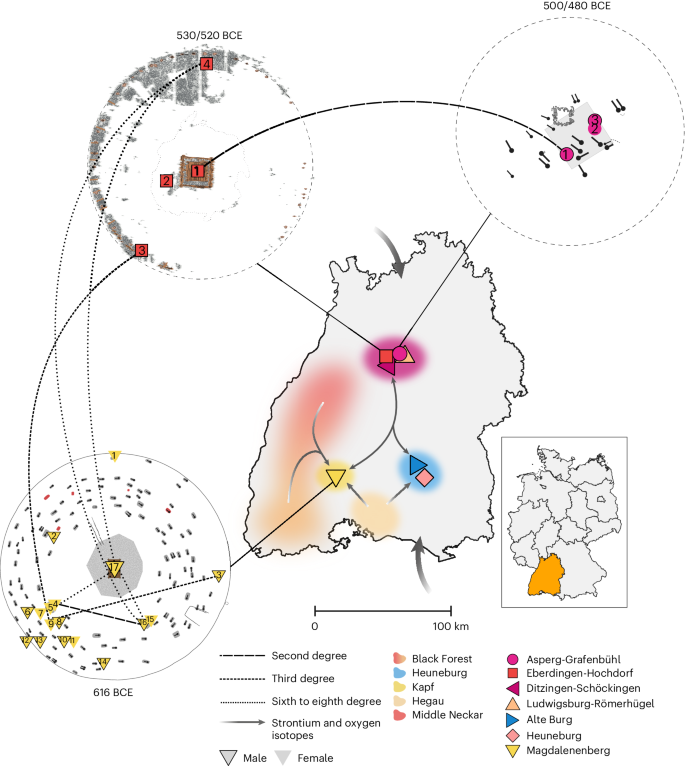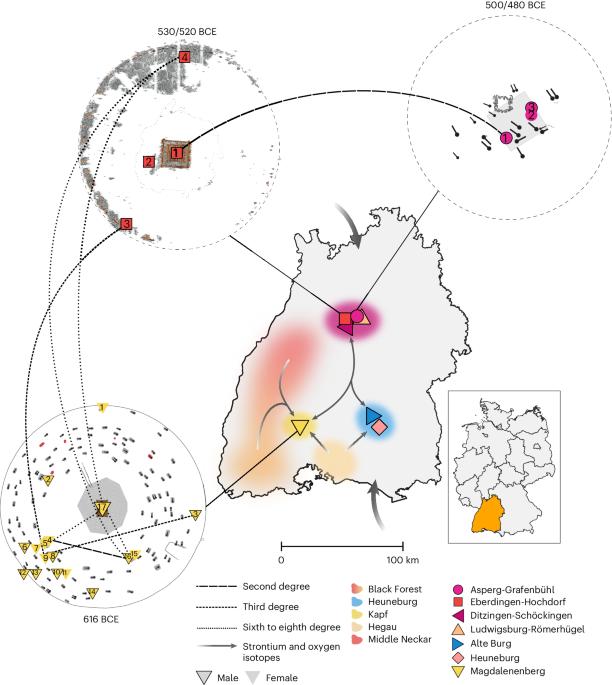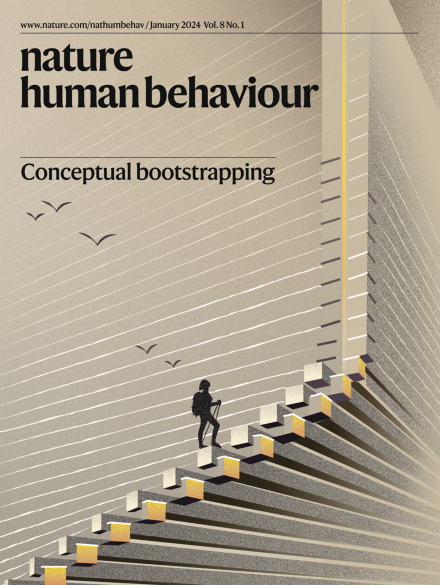Evidence for dynastic succession among early Celtic elites in Central Europe
IF 21.4
1区 心理学
Q1 MULTIDISCIPLINARY SCIENCES
引用次数: 0
Abstract
The early Iron Age (800 to 450 BCE) in France, Germany and Switzerland, known as the ‘West-Hallstattkreis’, stands out as featuring the earliest evidence for supra-regional organization north of the Alps. Often referred to as ‘early Celtic’, suggesting tentative connections to later cultural phenomena, its societal and population structure remain enigmatic. Here we present genomic and isotope data from 31 individuals from this context in southern Germany, dating between 616 and 200 BCE. We identify multiple biologically related groups spanning three elite burials as far as 100 km apart, supported by trans-regional individual mobility inferred from isotope data. These include a close biological relationship between two of the richest burial mounds of the Hallstatt culture. Bayesian modelling points to an avuncular relationship between the two individuals, which may suggest a practice of matrilineal dynastic succession in early Celtic elites. We show that their ancestry is shared on a broad geographic scale from Iberia throughout Central-Eastern Europe, undergoing a decline after the late Iron Age (450 BCE to ~50 CE). Gretzinger et al. examine genetic evidence from 31 Iron Age individuals in southern Germany and find that this early Celtic society probably had a dynastic system of matrilineal inheritance, with a network of well-connected elites covering a broad territory.


中欧早期凯尔特精英王朝继承的证据
法国、德国和瑞士的早期铁器时代(公元前 800 年至公元前 450 年)被称为 "West-Hallstattkreis",是阿尔卑斯山以北地区超区域组织的最早证据。该地区常被称为 "早期凯尔特人",这表明它与后来的文化现象有初步联系,但其社会和人口结构仍是一个谜。在这里,我们展示了德国南部这一背景下 31 个个体的基因组和同位素数据,这些个体的年代在公元前 616 年至公元前 200 年之间。通过同位素数据推断出的跨区域个体流动性,我们确定了三个精英墓葬中相距 100 公里的多个生物相关群体。其中包括哈尔施塔特文化两个最丰富的墓葬群之间的密切生物关系。贝叶斯建模表明,这两个人之间存在亲缘关系,这可能暗示了早期凯尔特精英的母系王朝继承习俗。我们的研究表明,从伊比利亚到整个中东欧,他们的祖先在广泛的地理范围内是共享的,但在铁器时代晚期(公元前 450 年至公元前 50 年左右)之后出现了衰落。
本文章由计算机程序翻译,如有差异,请以英文原文为准。
求助全文
约1分钟内获得全文
求助全文
来源期刊

Nature Human Behaviour
Psychology-Social Psychology
CiteScore
36.80
自引率
1.00%
发文量
227
期刊介绍:
Nature Human Behaviour is a journal that focuses on publishing research of outstanding significance into any aspect of human behavior.The research can cover various areas such as psychological, biological, and social bases of human behavior.It also includes the study of origins, development, and disorders related to human behavior.The primary aim of the journal is to increase the visibility of research in the field and enhance its societal reach and impact.
文献相关原料
| 公司名称 | 产品信息 | 采购帮参考价格 |
|---|
 求助内容:
求助内容: 应助结果提醒方式:
应助结果提醒方式:


